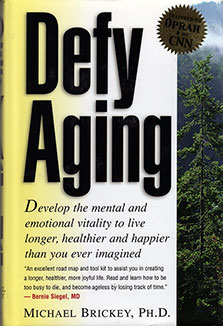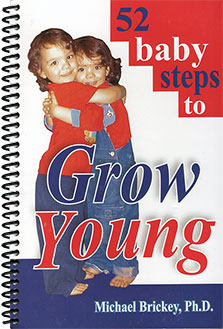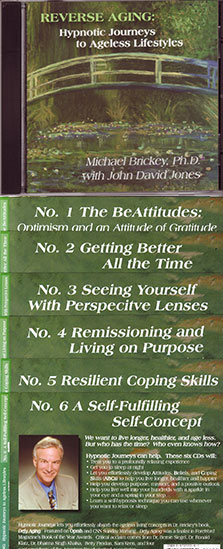The Defy Aging Newsletter
Anti-aging psychology, holistic health, and wellness
These are archives of a biweekly e-mail newsletter for helping you think, feel, look, and be more youthful and live with purpose.
January 22, 2009 Number 202
This issue:
The Other Green Revolution: Homier Nursing Homes
Action to take
Look for and support "greener," homier nursing homes.
Why
One of our worst nightmares is having to live the rest of our lives in a nursing home. There are almost 50% more nursing homes than McDonald’s restaurants in the US. While most are fairly well run, the structure and values of nursing home typically make them warehouses that strip residents of their dignity, independence, and any semblance of a normal lifestyle. No wonder so many older Americans ask their children to "Promise me you will never put me in a nursing home." It doesn’t have to be that way.
When we hear about the green revolution, we usually think of ecology and being kind to the earth. But there is another green revolution. It started when a Harvard-trained physician, Dr. Bill Thomas headed a nursing home and didn’t like what he saw. He brought in plants, pets, and a homey atmosphere and called it the Eden Alternative. More than three hundred facilities in the US and 200 abroad followed his model, at least to some extent. The result was kinder, more homey nursing homes in which residents and staff felt a sense of purpose and contribution.
But Dr. Thomas decided that wasn’t good enough. With his Greenhouse revolution, the nursing home became a cluster of small homes or cottages typically with six to twelve residents. Each had a kitchen that looked like the kitchen in a family home. Staff and residents prepared meals side by side and usually ate together as well. Instead of a medical model, staff and residents were like a family. There are now dozens of Greenhouse nursing homes. Many were funded by foundations.
You may be wondering about the cost. There is a cost in building a new facility (as there is with medical model nursing homes) or in converting an existing facility to a Greenhouse facility. Once the facility is operating, however, the costs are comparable to conventional nursing homes. One reason is low staff turnover rates. In conventional nursing homes, annual turnover rates are about 50% for nurses and almost 70% for aides. Recruiting and training new staff is very expensive. Even if the food is a little more expensive (and much healthier and more palatable) there is far less waste of food.
Getting nursing homes to change from a bureaucratic medical model to a person centered model can seem like a Herculean task. But it is an idea whose time has come. In the 1970s there were 413,000 Americans in mental health and mental retardation institutions. The deinstitutionalization movement in the 1970s and 1980s closed most of the institutions and moved the services to the local communities. Despite a growing US population, by 2000 there were only around 64,000 residents—about a sixth of the previous census.
What brought about the change? It started with the normalization ideology—a value system that championed having people with mental and intellectual disabilities lives as normal a life as possible. It was aided with legislation like the Community Mental Health Act of 1963, court cases, and the public’s disgust with snake pit institutions like the one depicted in the movie, One Flew Over the Cuckoo’s Nest with Jack Nicholson.
The reason I’m talking about the deinstitutionalization movement is that it shows that medical institutions can be radically changed. I’m amazed that nursing homes weren’t swept up in the normalization movement in the 70s and 80s. Today there are several factors that suggest there time has come:
- the ideological thrust from Dr. Bill Thomas and other person centered advocates.
- hundreds of facilities demonstrating that these models work and aren’t more expensive than the current medical model
- greater scrutiny of spending money wastefully, as in overmedicating patients
- Baby Boomer’s unwillingness to accept that kind of treatment—or for that matter even to grow old
- a growing awareness of what nursing home are like and how they dehumanize people.
- the federal government, CMS, the Centers for Medicare and Medicaid Healthcare services supporting the movement
- The efforts of the Pioneer Network Coalition.
Assisted living facilities have rescued almost a million people from having to live in a nursing home. Hospice drastically changed how people are viewed and treated in their final months of life.
I had the pleasure of interviewing Beth Baker, author of Old Age in a New Age, who describes dozens of facilities that really are homes. You can hear the fifty minute mp3 free at www.AgelessLifestles.com. If you want to learn more about how to advocate for the revolution, check out www.pioneernetwork.net, which is leading the effort to transform nursing homes. The changes Beth Baker talked about are critically needed and appear undeniable. Even yesterday isn’t soon enough.
Quotes
The time has arrived to let [the nursing home] go. Some would say it's broken. I say it never was fixed. It was never a healthy, nourishing thing.
~Steve Shields, a nursing home administrator
Humor
I'm kinda depressed right now because we had to put Grandpa in a rest home. Well, not actually: We didn't have the money. So we drove down the turnpike and put him in a rest area.
~Rich Vos
Reprint this article from:
THE DEFY AGING NEWSLETTER
Anti-Aging Psychology
Holistic Health and Wellness
This newsletter article may be reprinted in E-zines, newsletters, newspapers, and magazines provided the content is not edited and the attribution below is given. Formatting may be changed and you may use one of the web site pictures of the author to accompany the article.
"Dr. Michael Brickey, The Anti-Aging Psychologist, teaches people to think, feel, look and be more youthful. He is an inspiring keynote speaker and Oprah-featured author. His works include: Defy Aging, 52 baby steps to Grow Young, and Reverse Aging (anti-aging hypnosis CDs). Visit www.NotAging.com for a free report on anti-aging secrets and a free newsletter with practical anti-aging tips."






